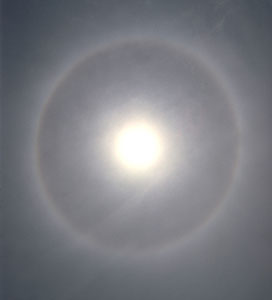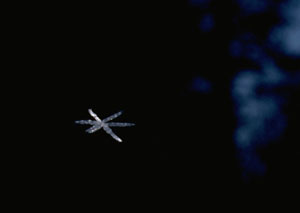
An ice crystal halo around the sun photographed from earth.
Martian Snow
by Paul Doherty

I love to spot halos of light around the moon and the sun. Their color and shape always brighten up my spirits, even though I know that seeing these halos often means that rain is in the forecast. So, in 1976, when the Viking spacecraft landed on mars and took images with its primitive digital camera I wondered if it would spot halos around the sun on Mars. Then I realized that Martian snowflakes might not be the same shape or composition as earth snowflakes and since I was a scientist I went to the library to find out the shape of Martian snowflakes. I searched for days with no luck. Then I realized that I had made a great discovery, no one knew the shape of Martian snowflakes. Here was my chance, I could grow Martian snowflakes in my laboratory and become the first person to know the shape of a snowflake on mars. So I enlisted a brilliant physics resource engineer Clarence Bennett and together we set off to grow and photograph Martian snowflakes.

Everyone knows that earth snowflakes are made of water ice crystals. They all have six sides. Scientist say that snowflakes have hexagonal symmetry. Over a century ago x Bentley collected and photographed snowflakes. He published his images in a book that shows snowflakes with many different shapes: thin flat hexagonal plates, hexagonal prisms shaped like an unsharpened pencil, and the usual six armed snowflake that I try to catch on my tongue. Even though all of these shapes have the same hexagonal symmetry they have different crystal habits. Over the decades scientists discovered that the shape of a snowflake depended on the temperature and humidity of the air that it formed from. warmer air with high humidity led to delicate six armed snowflakes. While cold dry air produced flat sided hexagonal plates or prisms.
Martian snowflakes I realized would probably be made of carbon dioxide ice, CO2, since 95% of the atmosphere of mars is made of CO2, and the temperature on mars sometimes sinks below the freezing point of carbon dioxide, and extremely cold 140 Kelvin's (-133°C or - 207 °F). Scientists already knew that carbon dioxide ice crystallized with cubic symmetry however, they didn't know its crystal habit when it formed under Martian temperature and pressure.
Clarence and I built a mars chamber, it had a vacuum pump to reduce the pressure inside the chamber to the pressure on Mars, less than 1% of the pressure on earth. (An average surface pressure on Mars is 6 millibars where 1 Bar is the atmospheric pressure on earth.) It also had a liquid nitrogen plumbing system to cool the chamber to under 140 K and allow carbon dioxide to crystallize. It was a strong steel chamber with a thick lexan window to withstand the tons of force exerted on it by the earths atmosphere when it was evacuated. It even had a cool circular handle to crank "dog" the access hatch. It made me feel like a submariner in a movie spinning the handle to seal the door.
Growing a snowflake turned out to be harder than we expected, but after months of growing frost we eventually produced a snowstorm in the chamber and were able to collect and photograph the carbon dioxide snow. crystals we had grown under Martian conditions. The photographs showed beautiful cubes of ice with every corner neatly clipped off to form a triangle. This is a shape called a cubeoctahedron &emdash; a cross between an octahedron and a cube. A cubeoctahedron has cubic symmetry so it fit the known symmetry of carbon dioxide ice. For a while Clarence and I smiled and reveled in the knowledge that we were the only ones who knew the shape of ice crystals on Mars.
But being scientists we quickly returned to work to try to see if we could be wrong. I decided to calculate the position of ice crystal halos around the sun on mars in hopes that the Viking landers would photograph them. For the calculation I needed to know the index of refraction of Martian carbon dioxide ice. I couldn't measure this myself, but I found other researchers who had. As in all measurements measurement had a possible range of error. Using their data and my shapes I calculated that one of the possible ice crystal halos on mars should be about 60 degrees from the sun.
When I see an ice crystal halo on earth, I reach out my arm and touch the moon with the tip of my thumb then stretching my hand as wide as I can I touch the halo with the tip of my little finger. The common halo is one handspan from the moon, about 22.5 degrees in angle. Few people look near the sun in the sky, I do. My reward is that sometimes I spot a halo around the sun. At sunset I sometimes spot two bright patches of color on either side of the sun called sundogs or parhelia. All of these phenomena are caused by sunlight shining through water ice crystals falling through earth's atmosphere. They occur dozens of times every year. The halos on mars would be three full handspans from the sun. They would be large halos.
I called up the Viking project at JPL and asked them if they had seen any ice crystal halos in their photographs. They said no and then asked an amazing question. "Where should we look?" I told them and that resulted in a scientific search through al of the photos. Alas, they spotted no ice crystal halos. However the mars pathfinder lander also took pictures of the sky, they spotted high thin ice crystal clouds but still no halos. Now, in 2003 two more rovers covered with cameras are going to mars. Perhaps this time they will spot a halo around the sun and bring back to earth proof of the shape of Martian snowflakes. They also have a camera with a powerful magnifier on it, a geologists hand lens on mars. This is the perfect tool for examining Martian snowflakes. If the landers are caught in a snowstorm they may be able to photograph Martian snowflakes and compare their images to mine. If that happened I would be in heaven, or at least on mars.
|
Scientific Explorations with Paul Doherty |
|
19 July 2003 |